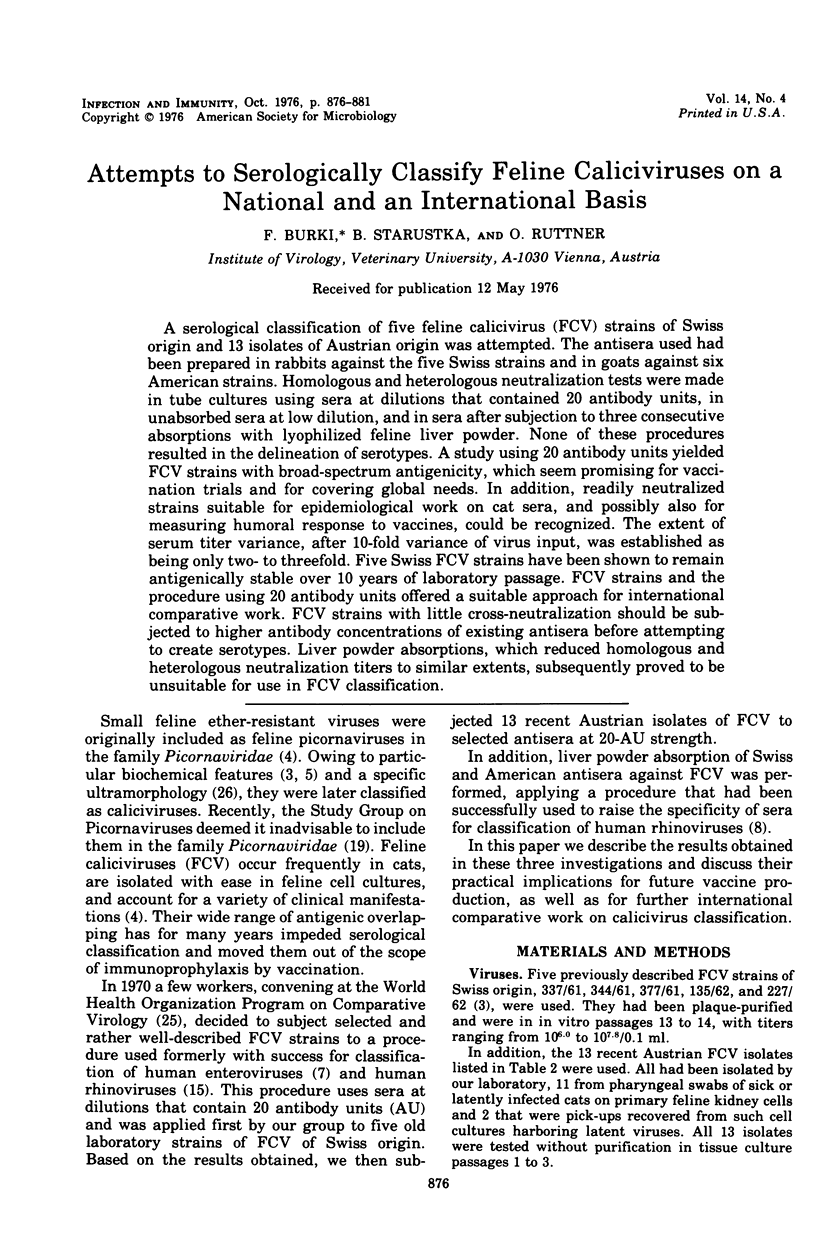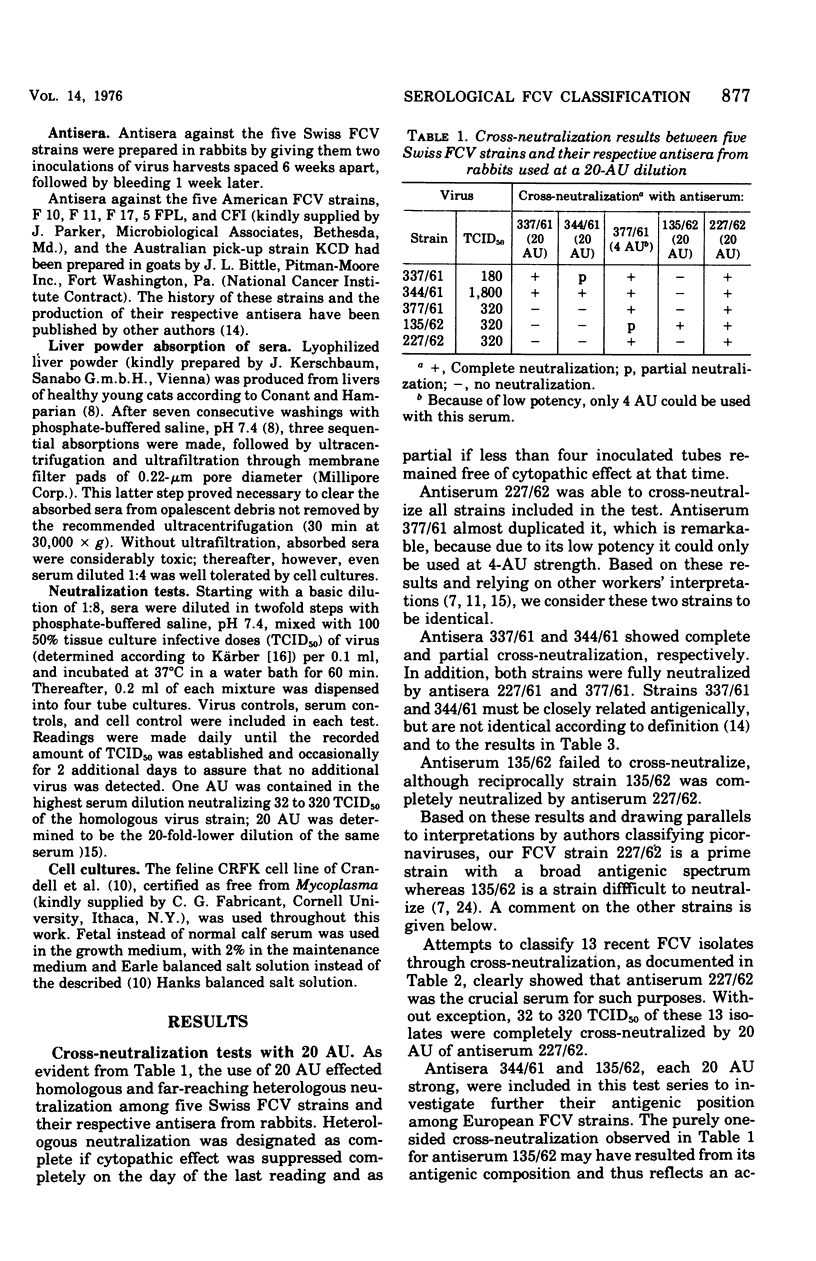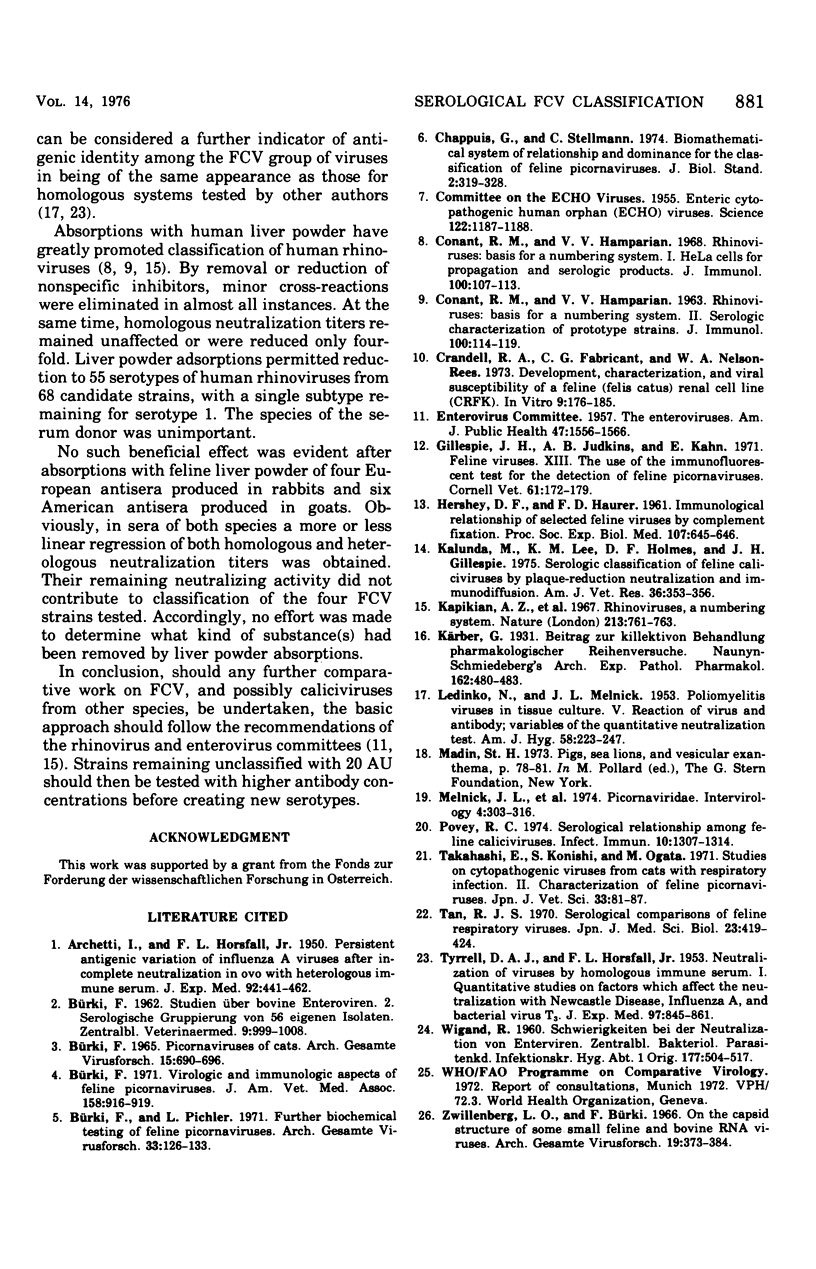Abstract
A serological classification of five feline calicivirus (FCV) strains of Swiss origin and 13 isolates of Austrian origin was attempted. The antisera used had been prepared in rabbits against the five Swiss strains and in goats against six American strains. Homologous and heterologous neutralization tests were made in tube cultures using sera at dilutions that contained 20 antibody units, in unabsorbed sera at low dilution, and in sera after subjection to three consecutive absorptions with lyophilized feline liver powder. None of these procedures resulted in the delineation of serotypes. A study using 20 antibody units yeilded FCV strains with broad-spectrum antigenicity, which seem promising for vaccination trials and for covering global needs. In addition, readily neutralized strains suitable for epidemiological work on cat sera, and possibly also for measuring humoral response to vaccines, could be recognized. The extent of serum titer variance, after 10-fold variance of virus input, was established as being only two- to threefold. Five Swiss FCV strains have been shown to remain antigenically stable over 10 years of laboratory passage. FCV strains and the procedure using 20 antibody units offered a suitable approach for international comparative work. FCV strains with little cross-neutralization should be subjected to higher antibody concentrations of existing antisera before attempting to create serotypes. Liver powder absorptions, which reduced homologous and heterologous neutralization titers to similar extents, subsequently proved to be unsuitable for use in FCV classification.
Full text
PDF





Selected References
These references are in PubMed. This may not be the complete list of references from this article.
- ARCHETTI I., HORSFALL F. L., Jr Persistent antigenic variation of influenza A viruses after incomplete neutralization in ovo with heterologous immune serum. J Exp Med. 1950 Nov 1;92(5):441–462. doi: 10.1084/jem.92.5.441. [DOI] [PMC free article] [PubMed] [Google Scholar]
- Bürki F., Pichler L. Further biochemical testing of feline picornaviruses. Arch Gesamte Virusforsch. 1971;33(1):126–133. doi: 10.1007/BF01254170. [DOI] [PubMed] [Google Scholar]
- Bürki F. Picornaviruses of cats. Arch Gesamte Virusforsch. 1965;15(5):690–696. doi: 10.1007/BF01245215. [DOI] [PubMed] [Google Scholar]
- Bürki F. Virologic and immunologic aspects of feline picornaviruses. J Am Vet Med Assoc. 1971 Mar 15;158(6 Suppl):916–919. [PubMed] [Google Scholar]
- Chappuis G., Stellmann C. Biomathematical system of relationship and dominance for the classification of feline picornavirus. J Biol Stand. 1974 Oct;2(4):319–328. doi: 10.1016/0092-1157(74)90041-9. [DOI] [PubMed] [Google Scholar]
- Conant R. M., Hamparian V. V. Rhinoviruses: basis for a numbering system. 1. HeLa cells for propagationand serologic procedures. J Immunol. 1968 Jan;100(1):107–113. [PubMed] [Google Scholar]
- Conant R. M., Hamparian V. V. Rhinoviruses: basis for a numbering system. II. Serologic characterization of prototype strains. J Immunol. 1968 Jan;100(1):114–119. [PubMed] [Google Scholar]
- Crandell R. A., Fabricant C. G., Nelson-Rees W. A. Development, characterization, and viral susceptibility of a feline (Felis catus) renal cell line (CRFK). In Vitro. 1973 Nov-Dec;9(3):176–185. doi: 10.1007/BF02618435. [DOI] [PubMed] [Google Scholar]
- Gillespie J. H., Judkins A. B., Kahn D. E. Feline viruses. 8. Th use of the immunofluorescent test for the detection of feline picornaviruses. Cornell Vet. 1971 Jan;61(1):172–179. [PubMed] [Google Scholar]
- HERSEY D. F., MAURER F. D. Immunological relationship of selected feline viruses by complement fixation. Proc Soc Exp Biol Med. 1961 Jul;107:645–646. doi: 10.3181/00379727-107-26713. [DOI] [PubMed] [Google Scholar]
- Kalunda M., Lee K. M., Holmes D. F., Gillespie J. H. Serologic classification of feline caliciviruses by plaque-reduction neutralization and immunodiffusion. Am J Vet Res. 1975 Apr;36(4 PT1):353–356. [PubMed] [Google Scholar]
- LEDINKO N., MELNICK J. L. Poliomyelitis viruses in tissue culture. V. Reaction of virus and antibody; variables of the quantitative neutralization test. Am J Hyg. 1953 Sep;58(2):223–247. [PubMed] [Google Scholar]
- Melnick J. L., Agol V. I., Bachrach H. L., Brown F., Cooper P. D., Fiers W., Gard S., Gear J. H., Ghendon Y., Kasza L. Picornaviridae. Intervirology. 1974;4(5):303–316. doi: 10.1159/000149863. [DOI] [PubMed] [Google Scholar]
- Povey R. C. Serological relationships among feline caliciviruses. Infect Immun. 1974 Dec;10(6):1307–1314. doi: 10.1128/iai.10.6.1307-1314.1974. [DOI] [PMC free article] [PubMed] [Google Scholar]
- Rhinoviruses: a numbering system. Nature. 1967 Feb 25;213(5078):761–762. doi: 10.1038/213761a0. [DOI] [PubMed] [Google Scholar]
- TYRRELL D. A., HORSFALL F. L., Jr Neutralization of viruses by homologous immune serum. I. Quantitative studies on factors which affect the neutralization reaction with Newcastle disease, influenza A, and bacterial virus T3. J Exp Med. 1953 Jun;97(6):845–861. doi: 10.1084/jem.97.6.845. [DOI] [PMC free article] [PubMed] [Google Scholar]
- Takahashi E., Konishi S., Ogata M. Studies on cytopathogenic viruses from cats with respiratory infections. II. Characterization of feline picornaviruses. Nihon Juigaku Zasshi. 1971 Apr;33(2):81–87. doi: 10.1292/jvms1939.33.81. [DOI] [PubMed] [Google Scholar]
- Tan R. J. Serological comparisons of feline respiratory viruses. Jpn J Med Sci Biol. 1970 Dec;23(6):419–424. doi: 10.7883/yoken1952.23.419. [DOI] [PubMed] [Google Scholar]
- WIGAND R. [Difficulties in neutralization of enteroviruses]. Zentralbl Bakteriol. 1960 Feb;177:504–517. [PubMed] [Google Scholar]
- Zwillenberg L. O., Bürki F. On the cpsid structure of some small feline and bovine RNA viruses. Arch Gesamte Virusforsch. 1966;19(4):373–384. doi: 10.1007/BF01250606. [DOI] [PubMed] [Google Scholar]


